 |
 |
Home

Wrestling

WWE

TNA

Tape Reviews

Other

Sports

Basketball

Football

Baseball

Hockey

International

Entertainment

Movies / TV

Music

Gaming

Technology

Books / Comics

" The Gravel Pit "

|
 |
 |
 |
Entertainment
>
Movies / TV
An Exercise in Poor Taste - The Thirsty Dead / The Swamp of the Ravens
Posted by Edward Robins on Dec 29, 2003, 04:15
|
|
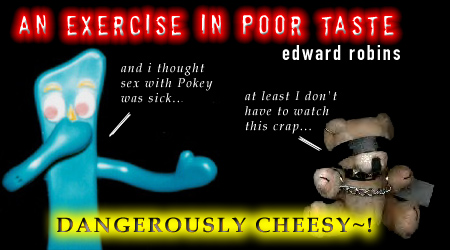
Heyo! Back from the dead, wishing you a merry belated�uhhh�whatever, I�m changing formats a teensy bit, since this is a slightly easier format for me to work with (for reference, and I�m only doing this once�4 humans in Thirsty Dead, 5 in Swamp of the Ravens), but it�s still a matter of me getting off my busy and lazy bum and putting columns together (maybe I should make a New Year�s resolution, eh?). Pop Culture�s really gone to shit�poor Jay is left all by his lonesome, with the occasional column or cut-and-paste Dr. Tom 411 column to back him up. I feel for you Jay, and I will always read you, my brother! Now if we could only get the almighty (and banned~!) Polk cranking out columns again, well, yes Virgina, that would prove there really is a Santa Claus. Too bad there isn�t. Not that it matters to me either way.
----
The Thirsty Dead (1973, dir. Terry Becker)
The Swamp of the Ravens (1974, dir. Manuel Ca�o)
Something Weird Video hasn�t been doing it for me this year. Sure, they�ve put out their usual share of sexploitation, but I originally became interested in Something Weird not for those releases (though I�ve since learned of their historical and entertainment values) but for their obscure horror titles. Since my primary interests are still of that variety, with the apparent death of the K. Gordon Murray line, I found few �must-sees� and even fewer �must-owns� this year, until this double feature of the Filipino production The Thirsty Dead and the Spanish-U.S. co-production The Swamp of the Ravens.
The Thirsty Dead opens with the sun setting over the credits as we introduce go-go dancer Claire shaking it like the proverbial salt shaker in a Manila nightclub. After her act, as a radio broadcast reports on a series of kidnappings that are feared to be connected to a Hong Kong slavery ring, she hears a knock on her door and finds herself snatched by a group of cloaked men. Elsewhere, airline stewardess Laura turns down a marriage proposal from suitor Francisco (in a hollow melodramatic moment that thankfully never fits into the plot again), only to also find herself a victim. The two, along with two other women, are led through the sewers, down a river, and through the jungle. One of the girls, Anne, stumbles and finds her kidnappers (now uncloaked and revealed as a group of Filipino strongmen) very interested in a small cut of hers; they heal it instantly by placing a leaf over it. Eventually the strongmen bring them to their employers: a cult of vampires led by Baru and High Priestess Ranu that worship a 500-year old disembodied head named Raoum that rests in a tank of blood. Laura is separated from the rest; her arrival was foreseen, and she�s offered a chance to join the cult as they perform their bloody rites. She refuses, and after a failed escape attempt, eventually convinces Baru to help her and the other women escape.
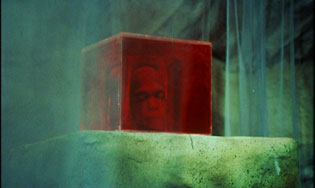 |
| I'm the man in the box... |
As a protagonist, Laura should be likable; after all, she gives up immortality to help a group of people she hardly knows escape a terrible fate she barely understands. Unfortunately, this is not the case; Jennifer Billingsley gives an annoyingly self-righteous performance � as she lectures Baru about friendship and the �real evil� of their means of eternal beauty, one wishes she�d just shut up. Much more likable and natural is smart-alecky anti-hero Claire, who brings a cynical sense of humor to the situation and eventually challenges Laura�s choice and refuses to leave. Of course, after a small catfight with Laura, she falls to her death in a cave. The High Priestess Ranu, with her long claw-like fingers and bizarre hairstyle, resembles an aging yuppie who, despite taking all means possible to preserve herself, looks simultaneously young and old. The only prominent male character, Baru dresses in a bizarre light-blue cloak that screams �cheap 70�s garb�, but offers a fairly sudden but believable turnaround as he rejects his entire way of life to help Laura (who is hinted to be a reincarnation of a lost love).
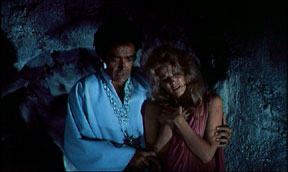 |
| "You da man, Baru!" |
There�s an interesting issue of choice beneath the surface of The Thirsty Dead. Unlike most women in exploitation, Claire states that she wouldn�t mind being a prostitute or �white slave� � to her, it�s money without a whole lot of work. Even when the cult�s true agenda is unveiled, Claire wants to stay, risking the premature death (which, given her occupation, is a more real possibility than with any of the other women anyway), disfigurement, and rapid aging of the cult�s victims for the chance of joining them. Ironically, for someone who extols the importance of choice to Baru and Ranu, Laura refuses to accept Claire�s decision to stay. Another interesting example of hypocritical choices surrounds the nature of the cult�s prophecy about Laura; she has been told to change their very way of living, and when she does that by rejecting their blood-drinking and immortality, they not only defy the words of their �divine one� Raoum, they also unceremoniously (no pun intended) rescind their previous offer of choice to Laura.
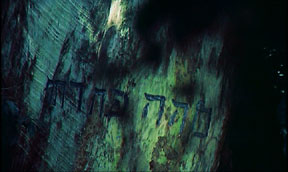 |
| "Funny you should mention that! My son too went to the Philipines and became a vampire cultist..." |
All theses on human nature aside, The Thirsty Dead is a surprisingly coherent low-budget Filipino adventure. Though lacking a lot of the action (and all of the gore) of other popular Filipino cult-horror films, The Thirsty Dead moves along at a great, steady pace (though a few of Laura�s more preachy dialogue-heavy sequences and one snake �attack� scene lacking the intended suspense could have been excised) and is quite watchable. Though its low-budget, like many, rears its ugly head at times (most notably with an incredibly fake hanging skeleton in one scene, and poor mic work picking up heavy wind noise that obscures dialogue in one of the final sequences), director Terry Becker effectively uses minimalist cave interiors and natural jungle exteriors to create a world that, particularly in still somewhat-uncharted areas like the Philippines, exists totally isolated out of the modern era whilst still in dangerously close proximity to �civilized areas�. Becker also employs a few stylistic flourishes (such as the opening credits, where a blurred red light is slowly revealed to be a police car as a siren blares through on the soundtrack) which, while infrequent and having little bearing on the simple story, are welcome.
Swamp of the Ravens, on the other hand, relies on its bizarre story elements and protagonist to stand out. The film opens with its protagonist, Dr. Frosta, flashing-back to a dismissal from a medical institution because of his far-fetched, views of the nature of death (�Death doesn�t exist; it�s merely a step of evolution, a state that can be corrected!�) and bizarre experiments that he claims can alter the state of death to one of life. As he does this, he injects a recently hung man with a strange elixir; his heart slowly but surely begins beating again, as the man sits up and screams. In the next shot, Frosta�s mute assistant (who may or may not be the man he just resurrected), dumps the body of a less-successful experiment in the nearby swamp. Another experiment, this time with a beggar who commits suicide after Frostra reveals his leprosy, fails, with another body dismembered and dumped into the swamp. Meanwhile, Frosta�s unhappy girlfriend, Simone, attends an old flame�s nightclub act, and after hearing him croon ballads about her, falls in love with him again. Frosta, not the sort of person you leave, kidnaps her, binds her, rapes her, and continues his experiments on her, that she may be with him forever. The disappearance of Simone, combined with the discovery of the dead leper�s dismembered hand, several other recent disappearances, and similar discoveries (occurring outside of the plot) lead the local Sheriff to devise a connection and suspect someone in the medical community. With more bodies mysteriously surfacing in the swamp, there�s plenty of evidence to lead the Sheriff to Frosta, but will he discover the true nature of Frosta�s experiments in time to save Simone?
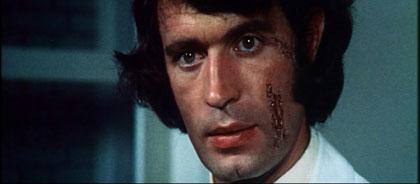 |
| "We all go a little mad sometimes. Haven't you?" |
If that plot description sounded dark and disjointed, it matches the film to a T. Swamp of the Ravens takes many elements from the typical mad doctor story � a genius obsessed with �crazy� theories (and a woman), an isolated house/laboratory on the outskirts of town, and the police hot on his trail. However, it skews them all; the doctor�s pseudo-philosophy and pseudo-science almost make sense, his obsession with Simone is taken to a disturbing climax of strongly implied necrophilia (Frosta caressing an apparently dead Simone is intercut with a flashback to them making love in better days), and in a reversal of the usual story arc, the Sheriff�s pursuit of the doctor becomes secondary in the plot. A lot of it works � particularly the �bad guy� as protagonist. Keeping none of Frosta�s actions a secret, alongside featuring him constantly expounding on his own theories and flashing back to his dismissal, not only heightens his disturbed nature, but makes sure the audience never loses track of how off-kilter he really is. It�s here where Raymond Oliver excels as Dr. Frosta, particularly when director Manuel Ca�o brings in a tight shot of his face as he delivers a chilling glare right out into the audience. Though the Sheriff is a wonderfully dark-humored character (another excellent performance by Spanish cult actor Fernando Sancho), keeping him on the sidelines doesn�t lessen his effectiveness as an antagonist or a hard cop (though at first he seems to inexplicably appear on the right track, with subsequent viewings his tough intuition become apparent). Another excellent stylistic trait is Ca�o�s use of the raven as a visual motif (besides living ravens flying about in many key scenes, Frosta has raven skeletons scattered amongst pickled fetuses in his lab) as well as a narrative one, where its appearance is a harbinger of death and misfortune.
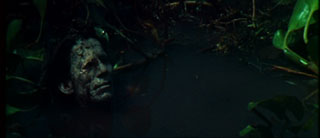 |
| Well I can't afford a REAL spa! |
Unfortunately, a lot of it doesn�t, as many elements (e.g. the rising corpses which are capable of murder and regeneration, but are unnoticed by all) only play into the story once as a tantalizing tease of the bizarre, and are either never resolved, or never play back into the story again; defying logic, these are present just for the sake of weirdness. There�s also the problem of action occurring off-camera; unlike the Sheriff�s �disappearance� and secondary role, which was intentional, either through a cut print or sloppy editing, at least one murder seems to occur in the middle of the film but outside of the plot (the victim leaves her friend, the film becomes very dark [see below], and the next scene cuts to her body at the morgue). A similarly strange presentation surrounds the other disappearances, murders, and body parts the Sheriff refers to through his dialogue and are inferred to have happened outside of the plot; though there�s a fair share of violence and gross-outs on display, it feels as if there should be a lot more. The score is a similar �win-lose� situation, with a simple, creepy piece utilizing both a flute and light synthesized back-up used for some sequences, and a really tacky synthesized �joyful love/victory� theme in others.
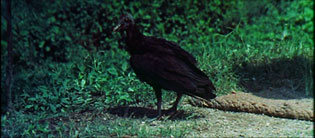 |
| What about me? |
Ultimately, Swamp of the Ravens� good manages to outweigh the bad. Unfortunately, it�s still difficult to sit through or recommend because of the poor print quality. Colors are incredibly dull and muddy; in many sequences the print is so dark the action is obscured (in a couple sequences it�s literally impossible to see anything). Although there aren�t a large amount of scratches or other film defects, when they are present they�re fairly extreme (lines and deep scratches around the reel changes), though compared to the poor colors they�re a walk in the park. According to Something Weird (and logic regarding the film�s ultra-obscurity), this is the only 35mm release print available, and although I�ve seen reviews of older generated tape releases (with burned in Russian subtitles) suggesting other prints are floating around in the gray-market/bootleg/tape trade market, with its one-off distributor (according to IMDb) and fake-sounding production companies (Mundial [Worldwide] Films and All-American Films), any hope of a negative or a really clean print seems lost. Luckily, its co-feature, Thirsty Dead features a pristine presentation; colors are vibrant throughout (although there is one occasion where they become dark for a couple minutes), and with the exception of the reel changes, there are very few scratches.
Neither film has its trailer present, but there are plenty of others in the �Portal of the Living Dead�. Included are trailers for Mary, Mary, Bloody Mary (a standard erotic thriller that�d look right at home if Cinemax had a �vintage skin-flicks� late-night marathon), The Sinister Monk (wherein a cloaked man with a whip murders London schoolgirls), Mario Bava�s classic Kill Baby Kill (strangely, in black and white, with this clever tagline: �You�ll Shiver and Shake, Quiver and Quake!�), Dead Eyes of London (a crime-thriller with a DVD on the way from Retromedia), The Vampire and the Ballerina (featuring some laughable vampire make-up), The Vampire�s Night Orgy (released through International Amusement Corporation, the same distributors of The Thirsty Dead, so it�s possible Something Weird or somebody has a nice print of this too), War of the Zombies (the odd one out, actually a sword & sandal epic featuring John Barrymore [Drew�s dad] as an evil sorcerer, though the trailer itself seems incomplete), and The Velvet Vampire (another erotic thriller). This is a strange reversal for Something Weird releases; usually the trailers are on par with or eclipse the main features (as is often the case in exploitation in general), but in this case, the only trailer I�ve kept revisiting is that for Kill Baby Kill (Bava�s beautiful framing and cinematography stand out even without their natural color), and maybe The Vampire and the Ballerina. Unlike other releases, there are no �must-releases�, with the most interesting title already being easily available (through both legitimate and cheap gray-market releases). Other special features include an episode of the Swedish TV series �13 Demon Street� (the episode, �The Black Hand�, is a somewhat interesting if unspectacular telling of the classic �criminal�s organ causes murderous impulses after transplant� story) and a gallery of old horror comics.
Something Weird�s returned to their roots (OK, their roots technically are the New York grindhouse and drive-in skin-flicks they normally release, but the horror are their roots to me) in style, and just in time. 2004 looks to be a good year, with a double-feature of the infamously awful auteur Andy Milligan coming in January and Something Weird�s first martial arts release in February. Whether I�ll be able to motivate myself to give those releases a proper review and recommendation is unknown, but rest assured�ummm, this is where I really needed a catchphrase for my columns when I can�t think of a proper conclusion. Guess it's back to the dead from here. Toodles!
�Til next time�or not?
- Ed
[email protected] (though you�d be better off PM�ing me feedback since that goes into my normal e-mail account, [email protected])
Of course, whether it�s late or not, or whether I deserve them or not, holiday gifts are always welcome ;-)
See what I wasted my holiday money on.
| |
|
|
|
 |

|